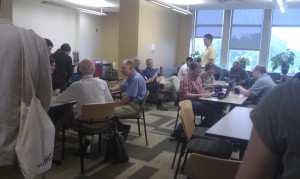This is the day of presentations and starting it off with a broken coffee machine was interesting and only took about 10 minutes to solve (with a pot full of fresh brew). After a few minutes we all filed into the lecture hall and began the talks.
1. Lipid layer problem: The question for this group was to model and understand the lipid layer of the eye and how the lipid layer behaves. They have movies showing the spreading of the thickness of the film as one blinks. Some of the questions being explored include:
- is evaporation playing a role?
- what is the stability?
- do features reappear between blinks?
They looked at evaporation of axisymmetric thin films and then one and two layers tear film model where the lipid layer with a surfactant sits on top of an aqueous layer.
The resistance in the meibum was treated as resistors in parallel to give an effective resistance of the layer. It was noted that experimentally the logarithm of the resistance is linear in the length of the carbon chain increases (larger for waxy esters and less for short chains).
One layer model: Lipid layer (surfactant) and an aqueous layer. There is a lubrication model for the thickness of the film and related expression for the concentration driven by variations in surface tension. By turning on evaporation there ends up being dry spots corresponding to the dry-eye syndrome. Adding in a lipid layer as a resistance still gives dry eye by in a slightly different spot on the eye.
Two layer model: Thin film lipid, an aqueous layer with Marangoni, capillary, viscous, Stokes and Peclet numbers all of order one. Velocities end up being linear in the layer and the concentration increases as the lid closes. Flat interfaces are stable but if there is noise on the thickness of the layer, this evolves in time but ends up giving a nontrivial steady state which may correspond to the invariant features that were seen. Looking at the evolution of a drop on the eye, it tends to thin over time. It was expected that perhaps the droplets seen in the eye are non-Newtonian or formed by dewetting and these effects might be dominant compared to the assumed dominance of surface tension that was explored. The point was that there is more going on than was first expected.
2. Calcium problem: This group started by analyzing a paper entitled “A minimal mathematical model of calcium homeostasis”. It was determined that after a day or so that since the emphasis of what was being explored was different than this paper that perhaps significant effort should be invested in developing a new model.
The ingredients of the new model are the bone, gut and renal system being modulated in their behaviour by the caltitriol through the parathyroid hormone and externally driven by one’s diet. This resulted in a system of four coupled ordinary differential equations (odes) in the amount of calcium, the amount of parathyroid hormone, the amount of calcitriol and the size of the parathyroid hormone glands. The model was also allowed to be excited by an excess of parathyroid to see if one could mimic the behaviour of the system when there is cancer of the parathyroid by the unregulated generation of parathyroid hormone. Renal disease was also able to be modelled by a decrease in the calcitriol production.
They were able to get a model that gave dynamics consistent with the normal state, cancerous state and renal failure. The parameters are chosen in the model to get the correct steady state and more time needs to be taken looking at the literature to try to extract relevant biological numbers.
3. Synaptic connection model: A lattice of neuron sites was proposed and the connections are expected to evolve in time. The question is to determine if you can extract the parameters of the system by observing the states of the system over time. A logistic regression approach was first attempted to do this since the gain function is inverted. The problem is that noise in the data effectively destroys any hope of this. To help handle this noise, a regularized method was used that controls the sparsity of the correlation matrix for the neurons.
The algorithms for estimating the synaptic connections used a direct inverse and a penalized logistic regression. The results were quite good on simulated data but dealing with real data is still quite a challenge. The trick is to try to pick an appropriate model with perhaps up to hundreds of neurones.
4. Fetal heart rate model: The goal is to determine the pathological versus healthy state of a fetus by trying to correlate the EEG and fetal heart rate, and to do this as early as possible to know if some intervention is required to reduce fetal stress. Data was taken from fetal sheep and the first modelling was simply to investigate the correlation function and see how early one can detect an anomaly. The spectral coherence, effectively a normalized Fourier transform of the cross correlation, shows that if there is a stressed state then this corresponds to a nontrivial peak in this measure.
Efforts were then made towards developing a model of fetal heart rate as a function of the umbilical occlusion. This gives an ode for the amount of brain nutrient as a function of the heart rate, blood pressure and amount of nutrient. If the heart beats faster then the consumption of nutrient increases but there is a saturation effect. This gives a stable equilibrium with a fixed point position that depends on the amount of occlusion. This model also predicted a peak in the spectral coherence of the model like what was seen in the data analysis.
Work now changed to the online detection of stress. The idea is to compare the long term with the short term trends and to detect significant crossing points and then at these points in the time series, determine if the synchronous time series in the EEG and fetal heart rate (indicating stress) can be detected.
5. Mirco-indenting problem: To begin with a two dimensional model for the indentation of an incompressible model for the tissue was attempted. There is a point force of stress at the upper surface, stress free on the sides and finally no slip on the lower surface.
Using the Airy stress function this was written as a biharmonic equation for the stress function and Laplace’s equation for the pressure with a number of compatibility conditions. It ends up that the vertical displacement for a single layer ends up being an exponential in the absolute value of the distance from the location of the point source on the surface.
The group then moved to a two layer model and it was found that the solution is a function of a rational function of the ratio of the stiffness in the materials. One of the interesting simulation results was that even though the indentation was on the top of the upper layer, there are situations where the maximal displacement could occur in the bottom due to the relative stiffness of the layers.
Finally a nonlinear elasticity model was derived to deal with the fact that the expected displacements of the layers were quite large. It was shown that by neglecting higher order terms that the linear theory was recovered so there is some hope that an estimate of how well the linear theory is modelling the behaviour can be captured.
Well-posedness of the inverse problem requires more information to solve the problem and not just a single indentation. It was suggested that perhaps indentation of different sizes could regularize the inverse problem.
6. Magnetic bead problem: Since this set of notes is really about this problem I’ll just recap the major points that were brought up.
- The number of magnetite beads that bind to a given cell has a probability distribution associated with it that reflecting how they are attached. For example, if we consider each interaction with a bead (during the bead seeding process) is an independent Bernoulli trial then obtain a binomial distribution in the number of attached beads.
- For a given number of attached beads there is an associated trajectory driven by an effective balance between the magnetic and viscous drag forces. The various cohorts of beads disentangle themselves but not before coming into contact with the scaffold. By knowing the trajectories, the concentration profiles can be easily evolved. Given enough of a distance to fall through, these various groups will separate and the concentration of each of the bands would reproduce the probability distribution.
- For the concentration model it is also clear that for a given fixed cohort of cells (i.e. all with the same number of attached beads) that the nonlinearity of the magnet only slightly modifies the contration profile as it evolves in time and extends into the scaffold.
- Much more work needs to be done with respect to the scaffold and this is where the immediate work should be focussed. It is not clear that just using an effective porosity will be enough at least with a crude model.
You might think that the adventure stopped there, but for anyone that has been to one of these workshops before you know that could hardly be further from the truth. Since this is the last day there is a flurry of activity within the various groups to ensure that they all have each others contact information, expense reports are submitted and and that arrangements have been made to get to the airport.
To keep in contact with this new group of researchers I opened a collaborative workspace in pbworks. Because this is an active research area this space is password protected but if you’d like to be involved send me an email and I’ll consider the request.
The final issue was the drive to the airport in the shuttle that was arranged by the MBI institute. Because of the pain in the butt of moving my suitcase around (I was not alone in this) I asked if I could go with the rest of the people (with suitcases) just stop at the hotel to pick up the bag left there. The driver was a bit put out but figured that this would be ok if it didn’t inconvenience anyone else. Strangely enough, it seemed that he did not understand which hotel we were at so we proceeded to arrive at a hotel downtown. Now it’s starting to get sticky. The hotel was actually on the other side of town and so we ended up essentially doing a complete loop. By this time people are starting to get worried that we’d not make it in time and once we were on the freeway a few of us brought out our iphones to find out how fast we were going. Someone I don’t think that the driver knew that was possible… moreover, I doubt he cared much at this point. To make a long story short, we all arrived in time and some of the flights were actually delayed.
All in all, this really was a wonderful opportunity and I hope that the MBI continues to foster this important activity and realizes the synergy this generates. I hope to see you at the next one!
For these last two images: Yes, these are oven doors with handles and working knobs… not sure why that decor in an airport bar. Above the clouds leaving an overcast and humid Columbus Ohio.



